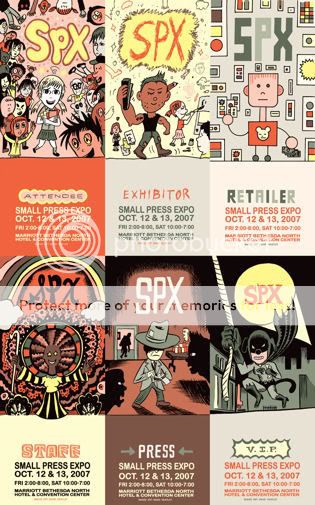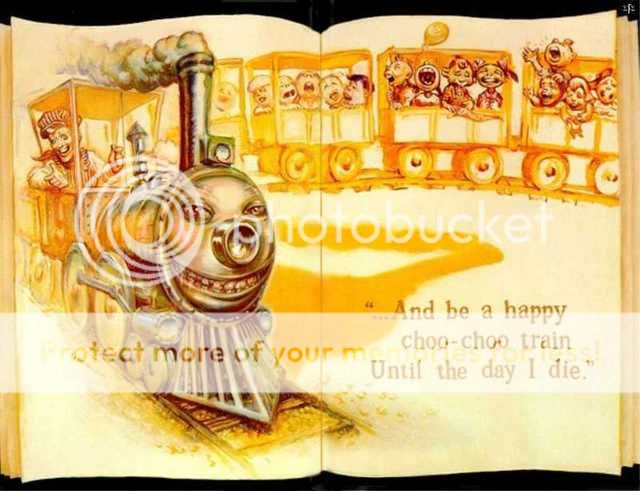Archive for October 14, 2007
The Return of the Thin White Sketchbook
October 14, 2007Now this is how you spend a weekend.
I could not have been happier with how my David Bowie sketchbook turned out at MoCCA. Did I try to go two for two at SPX? You’d better believe it! And here are the results.
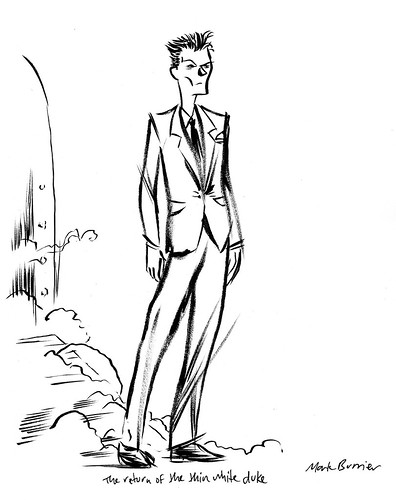
Mark Burrier: Mark got REALLY excited about the prospect of drawing Bowie. He gunned right for the Thin White Duke era, which is my favorite Bowie look as well. I’ve found that most artists who already know and love Bowie go for the Station to Station look. I also see some of his recent nattily attired vibe, circa Heathen and Reality, in this one.

Josh Cotter: Josh knew exactly what he wanted to draw–the cover for The Rise and Fall of Ziggy Stardust and the Spiders from Mars–and was extremely painstaking about doing it.
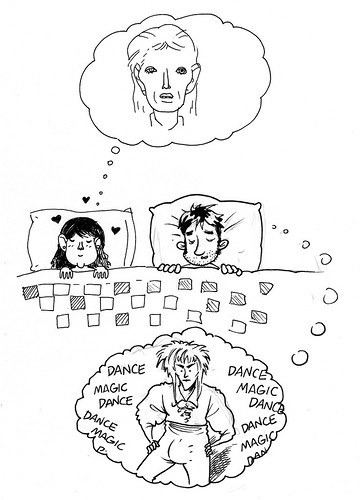
Eleanor Davis and Drew Weing: Eleanor (the dreamer on the left) and Drew (the dreamer on the right) are married, so they tag-teamed this sketch. Drew was the first artist to search high and low through my photo reference for a Labyrinth shot, but he wasn’t the last. For some reason, books about Bowie tend not to have big Labyrinth photos. Go figure.
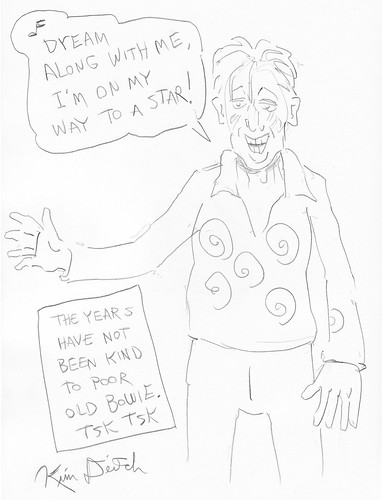
Kim Dietch: Bowie sings Perry Como! In an alternate universe, this really could have happened to David instead of to Rod Stewart. Dietch is a southpaw and as such is the only artist to sketch on a left-hand page in my book.
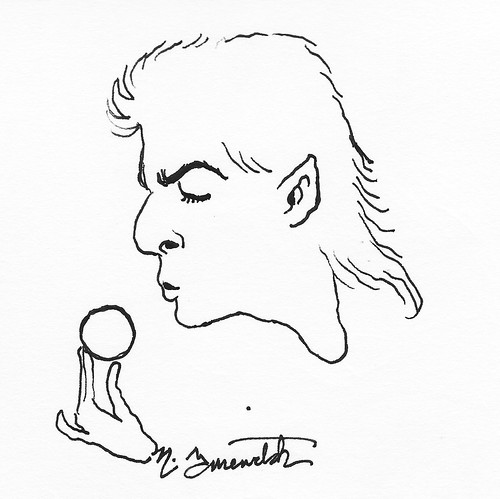
Nicholas Gurewitch: Another Labyrinthine sketch, with a Ziggymullet twist, from the Perry Bible Fellowship auteur. It looks like it could have come straight from the strip.
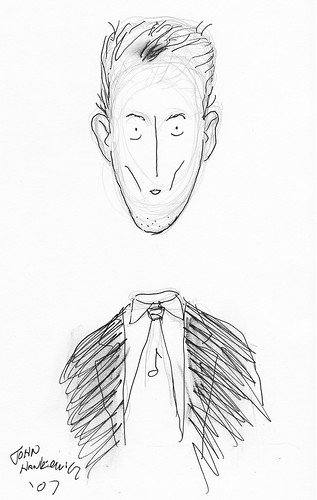
John Hankiewicz: I could see this bifurcated Bowie wandering around one of the dreamscapes in a John Hankiewicz comic really easily.
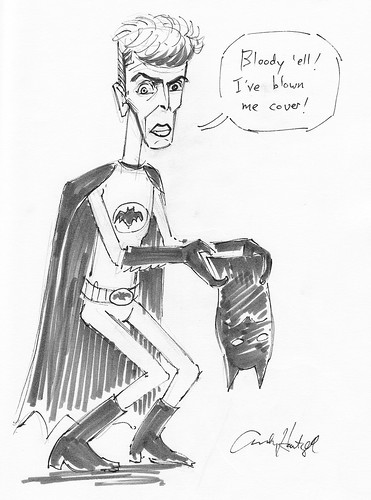
Andy Hartzell: The reason I ask people to draw David Bowie is that I really dug my friends’ themed sketchbooks, but they tend to be based on obscure superheroes they love, like Lockjaw, Nova, or Matter-Eater Lad. The only superhero I love is Batman, which would be kind of played-out to ask comics artists to sketch, so I went with Bowie. I explained all this to Hartzell, and the next thing I knew I had this awesome mash-up.
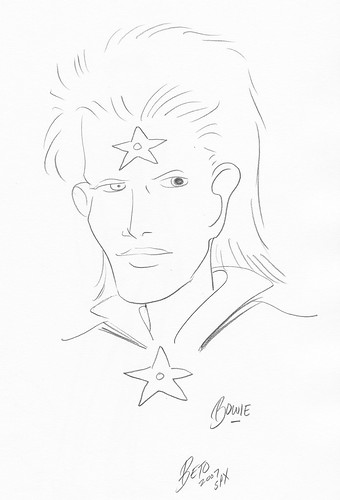
Gilbert Hernandez: I was absurdly starstruck as I watched Beto draw, as much as I was by Charles Burns. Gilbert didn’t need photo reference, and even knew which eye had the dilated pupil–and that Bowie’s still angry at the kid who roughed him up and caused the condition decades ago. I’m still pretty stunned I got to watch Gilbert Hernandez draw.

Kevin Huizenga: Kevin seemed to want to get this exactly right–he sketched and erased at least two rough versions before nailing this one. I really love the powder blue–I know exactly which outfit this is modeled after–and the paraphrased quote from “Moonage Daydream.” That actually sounds like the name of a Kevin H. comic, now that I think about it.

Paul Karasik: Karasik was a very good sport about drawing Bowie for me despite professing an active dislike for him and for popular music in general. We spent most of the time he was sketching debating whether Bowie was worth a damn, which was fun, if a little intimidating. Note: This is a mash-up between Bowie and Stardust (not Ziggy), the godlike super-“hero” from the comics of Fletcher Hanks, a collection of which called I Shall Destroy All the Civilized Planets Karasik edited.

Matt Kindt: Old Bowie dreams of young Bowie. It’s like Gandalf blowing glam smoke rings.
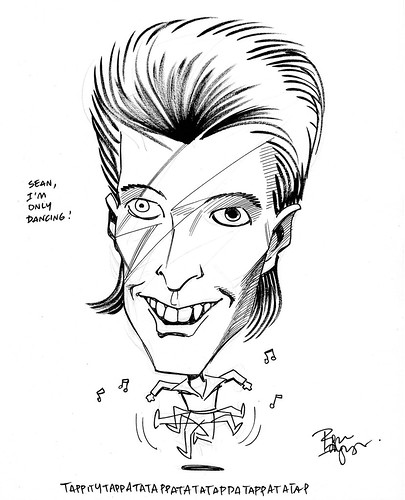
Roger Langridge: Langridge kicks it caricature-style. There’s a bit of vaudeville in both Langridge and Bowie, so this is fitting, I think.
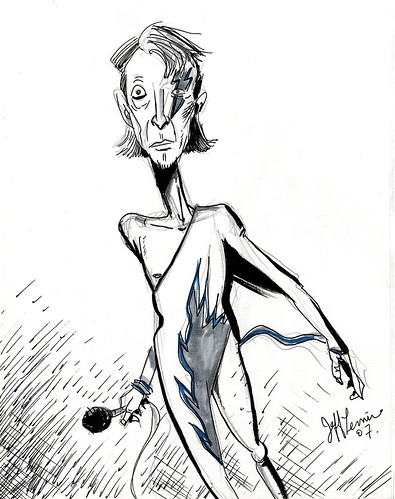
Jeff Lemire: I knew Jeff would create something memorable the first time I saw some of his strangely haunting superhero-sketch commissions. And again, I love the powder blue.

Ted May: Kevin Huizenga suggested that I seek out Ted May for a sketch because he’s a huge Bowie fan. He definitely took the sketch very seriously. This profile shot is on the cover of Low, my favorite Bowie album.

Brian Ralph: The ever-popular pirate look makes a comeback. I don’t know if it’s just because Brian’s drawn monkeys in his comics, but between the lanky limbs and the tail-like mic cord, there’s something simian about this Bowie.
Finally, here’s one that’s somewhat NSFW if your boss happens to be paying enough attention:

Tom Neely: In color! Tom is one of only three artists from whom I have original art–a drawing of the Creature from the Black Lagoon I won on a contest on his website–so it was a pleasure to get his take on Bowie.
For the original set of sketches, click here, or peruse the whole shebang as a Flickr set.
Don’t say Harry Knowles never did anything for you
October 14, 2007He personally convinced Sylvester Stallone NOT to change the tile of John Rambo to Rambo: To Hell and Back.
This is what John Rambo looks like, by the way.
Metacomics: storytelling and its discontents
October 14, 2007Even while I was at SPX and offline for pretty much 48 hours, I still heard quite a bit about Heidi MacDonald’s essay decrying a perceived lack of respect for traditional character and storytelling values among today’s young cartoonists. Most objections to it have focused whether her arguments are supported by any valid examples of young cartoonists who actively dislike such comics, or whether she ignored many genre-based works that are respected and admired these days, but my problem with it is more fundamental. Simply put, why should storytelling and character be paramount concerns? That’s like calling pop music a failure unless it’s Tommy or one of Ghostface Killah’s cocaine-deal narratives. It’s imposing a narrative fiction or film model onto an artform that can just as easily incorporate the influences of poetry, fine art, music, freakin’ dancing.
Many of the new comics that have meant the most to me over the past three years–a time during which I’ve also read and loved any number of books by authors primarily concerned with story, from Gipi and Jason to Bryan Lee O’Malley and Becky Cloonan to Ed Brubaker and Grant Morrison to Minetaro Mochizuki and Ai Yazawa to Nick Bertozzi and Jordan Crane–have been primarily concerned with mood, emotion, and rhythm rather than telling gripping yarns. That seems perfectly fine to me. A conception of comics that invalidates Kevin Huizenga’s “The Sunset” or Anders Nilsen’s The End or John Hankiewicz’s Asthma is not a useful one to me, or probably to comics.
Belated blogslinging
October 13, 2007Today will probably be a skip day as I am out and about at SPX. Thank you for your patience.
The Blogslinger: Blogging The Dark Tower, October 2007–Day 12
October 12, 2007Read: The Waste Lands–the rest of “Town and Ka-tet“
Nothing beats the catharsis you feel when characters do exactly what they should do. In this case that thing is answer by proxy the prayers of a million angry Lost critics and just sit around and compare notes. (Lost‘s creators are fond of citing their storytelling debt to King, with whom they’ve formed a mutual admiration society; maybe the bard of Bangor should point this passage out to them and say “how about you have Jack, Locke, and Juliet just sit down and explain shit to each other for about 45 minutes?”)
The menace of Charlie the Choo-Choo/Blaine the Mono continues to grow. I’m still concerned it’ll be much ado about nothing, but for now I’m content to enjoy the strength of the images conjured in that storybook. Using Underworld’s “Dark & Long (Dark Train)”, which was the song that played during the withdrawal hallucination sequence in Trainspotting if you recall, as my mental soundtrack for all things locomotive in this book is certainly helping.
Two other notes:
1) I think I realized why Susannah and Eddie just don’t work as foils for Roland, even while the mere hints and suggestions we’ve received about his former companions like Alain and Cuthbert are so fascinating–it’s because the former feel like real people and the latter like mythic archetypes. That sort of thing can frequently work in the real-feeling characters’ favor, but not in this dark fairy-tale world.
2) For a second there, when Roland was upbraiding himself for mistaking Eddie’s free will for his ka, I thought I’d suddenly and finally figured out how the Presbyterians reconcile predestination and free will. You’ve got a path (predestination/ka) laid out for you and you’re gonna travel it one way or another, but you can still choose to do so or not. But this falls apart when applied to the Presbyterians, because while it seems conceivable that someone’s ka could draw them into a quest like Roland’s against their will, I’m pretty sure no one’s supposed to go to Heaven thinking “man, this is bullshit!”
Quote of the day
October 12, 2007I waged a campaign this year against horribly violent horror movies and especially torture porn. I really shamed the Hollywood execs making money on these movies. I do believe that no Hollywood player should earn a dime from a film he’s ashamed to show in his own home. Then other journalists started doing the story. I’m not saying I’m solely responsible, but it’s been gratifying to see that those movies have gone from doing very well at the box office to doing almost no business.
—L.A. Weekly‘s Nikki Finke in Elle Magazine
Obviously it’s a gloriously idiotic quote for any number of reasons, but I think one that’s likely to be overlooked is her ghastly standard for which projects Hollywood execs should greenlight. By the “ashamed to show in his own home” rubric, I’m guessing a lot of now-classic movies wouldn’t have made the grade.
(Via Glenn Kenny, via Matt Zoller Seitz)
SPX FTW
October 12, 2007Today I will be going to the Small Press Expo with a small coterie of my friends and former co-workers. A bunch of new Bowie sketches and perhaps some sort of con report may follow. If you’ll be there, look for me.
The Blogslinger: Blogging The Dark Tower, October 2007–Day 11
October 11, 2007Read: The Waste Lands–“Town and Ka-tet,” parts 1-15
After a long, long time, the Dark Tower series once again starts feeling like how I, based on The Gunslinger, imagined the Dark Tower series would feel. The group (now a fivesome with the addition of Jake and his newfound pet billy-bumbler Oy) enters a run-down old town at a crossroads, meets its elderly but decent inhabitants, and bam! We’re back to the batwing saloon doors and archaic speech of the Clint/Conan mash-up that was the first book. As I’m sure you’ve guessed, I think that’s pretty swell.
I like all this business with the evil choo-choo train, too. I do hope that the pay-off is worth the build-up, though. I worry that this note is being hit a little too hard and too often, and that I’m gonna end up disappointed.
And I liked hearing the dimly remembered oral history of how Road Warrior-style anarchy beset the city of Lud and its surroundings; more of that sort of thing and less of Eddie and Henry playing one-on-one, please. It seems like the impression I got that Roland’s world is seriously on its way out was accurate, and not just because of the mystical spacetime-breakdown stuff–we’ve learned that every major population center/bastion of civilization has been destroyed, that their inhabitants have been scattered and left to fend for themselves in completely isolated communities with no real means of interacting with one another, and that no one on any side of the myriad conflicts is having much luck reproducing. It’s not just Mad Max, it’s also a bit of Children of Men, but with Clive Owen’s adventure maybe 30 or 40 years back in the rear-view mirror. It’s a sad, dying world and I want to see more of it in that light.
The Blogslinger: Blogging The Dark Tower, October 2007–Day 10
October 10, 2007Read: The Waste Lands–“Door and Demon”
Compared to yesterday’s reading, this section was kind of by the numbers. The Dean Brothers remain a whole lot less interesting than a post-apocalyptic cowboy shooting at giant cybernetic bears, and the bit in the haunted house with Jake was like a less frightening version of the house on Niebold Street from It, or the Marsten house from ‘Salem’s Lot, or the Overlook Hotel from The Shining, or or or. But I did like this passage an awful lot:
She put a hand on the back of his neck, pressing his head against her thigh, and said bitterly to Roland, “Sometimes I hate you, big white man.”
Roland placed the heels of his hands against his forehead and pressed hard. “Sometimes I hate myself.”
That’s the appeal of the gunslinger–a guy so driven to do the right thing and fulfill his quest that he becomes loathsome even to himself.
In other news, I detected some thematic allusions to other King books–the constant injunctions for the characters to “stand” and the notion that life is a wheel that keeps coming around to the same place again are awfully familiar. Meanwhile, Susannah-Detta’s I’ve got you/you’ve got me sex duel with the demon was pretty much the ritual of Chüd from It.
One final note: They really have to stop putting the illustrations before the passages they illustrate. The damn book keeps spoiling itself!
Metacomics: newest hippest latest
October 10, 2007There are other ways to treat comics as a commodity rather than an art besides viewing them as product. Probably the most prevalent these days is to implicitly (or explicity) equate–or supplant–quality with popularity. Here’s an example of that mindset from a letter to Tom Spurgeon from Winston Rowntree:
Your web site is focused primarily on print comics that Nobody Reads. There are thousands, like myself, who think of comics primarily as an online medium and we read online comics almost exclusively…We see the internet as the Future of comics, and are aware of emerging business models that support this theory by proving that online comics can succeed by selling merchandise and advertising associated with a freely-distributed webcomic. This is, in fact, The Future. Pretentious Art Comix from Drawn & Quarterly that 130 people buy are not the future. They are The Problem. Your website seems to ignore The Future…Granted, The Future of comics has not arrived yet, but you’ll look really smart if you get on the bandwagon now before it fills.
Rowntree goes on to offer a mea culpa about his belligerence and manages to note the “high quality” of many online comics, but that last is clearly an afterthought. The point is that online comics get big ratings, and that they can make money, and that they are therefore (love the caps!) The Future. As I’ve frequently alluded to, you often see similar argumentation deployed in favor of manga or OEL. While not quite as vociferous, the enthusiasm shown when anyone signs a deal with a major New York publishing house, especially while still young enough to get carded at bars, even if it’s to adapt some YA widget-factory novel series or something, is a related phenomenon. These cool, comparatively new, comparatively popular forms of comics, or at least their partisans, are here, they’re hip, and they’re banging their shoe on the table, so be warned, pervert-suit enthusiasts and sad-sack arthouse navel-gazers: They will bury you.
Curiously, however, audience size and financial success are not seen as points in favor of, say, superhero comics when Civil War sells more copies than anyone thought the Direct Market capable of moving anymore. And rightly so, because that’s a crazy reason to get excited about a comic, let alone its entire genre or format. It’s one thing, as an industry watcher, to be happy that this art form is finding a sizable audience beyond the strictures of the superhero industry, or that genres other than “extraordinary protagonist solves problems through violence” are at long last thriving, or that these new audiences are making it possible for creators to earn a decent living doing what they enjoy, or that this influx of cash and caché is persuading the arbiters of taste to treat comics with the seriousness it deserves. Long-time readers of ADDTF, from back during its first iteration as a comics blog, will likely remember me doing just that every time I saw those lovely rows and rows of tankubon trades at Borders or spotted a graphic-novel trend piece in any publication with the words New York in the title. But as readers or as critics or especially as creators, the second Drawn & Quarterly is dismissed as “The Problem” because Skibber Bee Bye is read by fewer people than Diesel Sweeties, something has gone horribly, horribly wrong.
I’ve said this recently and so have others, but for serious: You just cannot care about keeping up with the Joneses if you want to make good comics, or want other people to make them. You can’t. Naruto‘s Bookscan rankings, or the Flight kids getting a book deal during their sophomore year in animation school, or Penny Arcade‘s readership mounting a credible third-party presidential campaign or whatever–these phenomena may or may not involve good comics, but they don’t replace good comics, or the need to apply all the usual standards in deciding whether they’re good comics (and therefore good for comics in the way that really matters) or not in the first place.
Torture porn still in style
October 10, 2007For the record, count me as one who does not object to the interrogation to which [Khalid Sheikh Mohammed] was reportedly subjected, including waterboarding. This is not because I take the use of waterboarding lightly (although I have a hard time concluding that a technique, however terrifying, to which CIA officers are willing to subject themselves experimentally can properly be counted as torture). It’s because I take the threat posed by KSM seriously….when the moral trade-off comes down to KSM waterboarded in order to extract actionable intelligence, or some mother’s child murdered, it’s not a tough call.
–Brett Stephens, “So Be It?: The dangers of defining torture down,” the Wall Street Journal
Who needs Eli Roth?
Quote of the day
October 10, 2007Mrs. Voorhees is the perfect mother: Not only will she kill for her son, she’ll die for him.
–Betsy Palmer, aka Friday the 13th‘s Mrs. Pamela Voorhees, Going to Pieces: The Rise and Fall of the Slasher Film
The Blogslinger: Blogging The Dark Tower, October 2007–Day Nine
October 9, 2007Read: The Waste Lands–the rest of “Key and Rose”
I don’t know if it’s my buddy Bill’s encouraging words or what, but to paraphrase Gibby Haynes and Ministry, all of a sudden I find myself in love with this book–something about this section really ding a ding danged my dang a long ling long. I liked Jake’s moment of clarity in the vacant lot as the true workings of the world were revealed to him. I like that someone or something knocked his ass out with a brick (surely given Jack Mort’s number on Odetta back in the day, that’s no coincidence), and that the action picks back up with this mystery unsolved. I like the fragment of the poem about the Turtle. I like Jake going home and pwning his dad with his eyes apparently literally on fire. I like that the French teacher was nice to him. I LOVE that he got an A+ on his crazy English essay. I like that he kind of made up with his mom and dad and it wasn’t that kind of irrevocable years-in-the-making blow-out that you see with some frequency in King’s work (cf. Frannie and her dad vs. her mom in The Stand, Eddie vs. his wife and Eddie vs. his mom in It, etc.). I really REALLY loved the Charlie the Choo-Choo story and the frightening suddenness with which you realize “whoa, this has gotten weird, hasn’t it?” (cf. Beverly Marsh’s coffee date with Mrs. Kersh in It). I like that that section meshed so well with the haunting, driving song “Moss” from Gus Gus’ latest album Forever which I’ve been listening to all day. I like that the voices of Jake’s bifurcated memory (with which I had so much trouble) are now bickering like annoying monsters in a children’s story:
Quit! he screamed at them. Just quit! You were gone all day, be gone again!
I would if he’d just admit I’m dead, one of the voices said.
I would if he’d just take a for God’s sake look around and admit I’m clearly alive, the other snapped back.
And I fucking ADORED this:
Ned Dameron FTW!
I’m back, back in the Dark Tower groove. (For now. No promises!)
Metacomics: product
October 9, 2007…I think it’s not only excellent that DC is publishing a line for teen female readers, it’s doubly excellent that there’s a teen female writer involved in the line as well. So my instinct is to write something that would, in effect, praise all involved–in essence, give them a tickertape parade and the key to the city.
—Jeff Lester, on DC’s Minx line in general and Mike Carey, Louise Carey, and Aaron Alexavitch’s Confessions of a Blabbermouth in particular.
I think this is an instinct worth fighting against. I’m saying this without having read any Minx books, so that’s not a dig against them or the line at all. What I mean is twofold:
First, consciously gearing your entertainment product toward a particular demographic is a value-neutral act. This may be less apparent in comics because the art form in North America has been so completely dominated for so long by products geared toward men in their teens, 20s, and 30s, with that age bracket edging upward year in and year out, which makes it look like a comic geared toward any other group is half-act of charity, half-revolutionary declaration. But it is in fact still the case. It’s not remarkable that there are books and movies and TV shows geared toward women and men and teens and tweens and gay people and black people and whatever else, and it really shouldn’t be that remarkable that the same is true in comics. What would be remarkable is if they were good comics, regardless of the target demographic.
Second, involving a member of the target demographic in the creation of entertainment product for that demographic is also value-neutral. It can be good, it can lend authenticity to the work, it can lead to writing with an ear for the attitudes and dialogue inherent to that demographic, but it could just as easily do none of those things. John Kerry and John McCain are Vietnam veterans and by most accounts behaved admirably during that war, but I doubt either of them would make better Vietnam movies than Francis Ford Coppola or Stanley Kubrick. So having a teenage girl co-write a comic about teenage girls for teenage girls is unremarkable. What would be remarkable is if it were a good comic, regardless of who wrote it.
You’ll notice that I’m using the word “product” here. I use it to refer to art that is intended to serve a demographic first and foremost, before any other concerns, possibly even before any other ideas about the work form in the heads of the creators at all. Again, I’m not doing this to slag on the Minx line, with which I’m not terribly familiar other than to say that Jim Rugg drew one and I love Jim Rugg and that book looked really lovely when I flipped through it. In that same piece, Jeff puts it thusly:
DC’s Minx line openly promotes itself as being for female teen readers and I think that’s good: OGNs aimed at teen females is a market that’s worth tapping into; the more teens, females, and female teens we get reading comics the better; and if a teen who wanders into a shop looking for the next Minx book ends up picking up, say, Jaime Hernandez’s Locas, then, really, the whole thing is worth it. But by creating a book line with such a clearly defined target audience and a clearly defined goal, you’re one step closer to creating books that are more product than art. And while I don’t have a particular problem with that–I don’t mind picking up a Minx book knowing it’s unlikely I’m going to read some intense work of raw personal vision, the next Diary of a Teenage Girl by Phoebe Gloeckner–I do think the closer a work comes to being product, the higher the expectation becomes that the product be of professional standards.
What’s interesting and maybe troubling about this formulation is that making great comics is an ancillary concern at best. These comics are supposed to be worthwhile 1) because teen females are an underserved market; 2) because introducing women and teenagers to the industry is good for the bottom line; 3) because maybe they’ll eventually lead those women and teenagers to pick up comics that are great. But the possibility of being a work of Diary of a Teenage Girl-level passion and genius isn’t even entertained.
Mind you, the only reason I’m focusing on this particular demographic is because I noticed Jeff’s post; the same things can be said for any number of “new mainstream” efforts to provide competent genre-based entertainment for the non-superhero, non-art comics, non-manga comics readers out there, or the theoretical ones that might manifest were such comics made available. I don’t doubt for a second that there are tons of great romance comics and young-adult comics and action comics and detective comics (as opposed to Action Comics and Detective Comics, which happen to be pretty good themselves these days) floating around in some cartoonists’ heads out there quite independent of whether a targeted line or a company that specializes in getting its books optioned by Hollywood exists to publish them, or that some of those comics do indeed end up at some of those outlets. I just want to see things proceed in that order. Anything else strikes me as a desire to create the comics equivalent of a sitcom that NBC aired after Friends or an action movie you might half-watch on a cross country flight. What’s really strange about it is that in some quarters this is seen as some sort of triumph for comics. It’s like, I can see where Kim Thompson was coming from when he perjoratively said “more crap is what we need,” but it’s weird to me that people are excited to create it, or to champion its creation.
Blogslinging: Reload
October 9, 2007I was just about ready to abandon the Blogslinger project today, because I just haven’t been enjoying the books (aside from The Gunslinger), and there are plenty of other books in the sea. So kudos to my old pal Bill DeFranza for unwittingly writing in at just the right moment and saying enough intriguing and encouraging things about the rest of the series to keep me going. Perhaps not at the same clip–I might as well get over the idea that I’ll finish all seven books by October 31st–but at least for the moment, I’m gonna keep on trucking.
Carnival of souls: special “October is the cruelest month” edition
October 9, 2007As part of its 31 Days of Horror October blogathon, Not Coming to a Theater Near You’s Adam Balz reviews Who Can Kill a Child?, a Eurohorror children-run-amok flick cited by Eli Roth in his defense of a scene that deigned to answer that question in Hostel Part II.
As part of his 31 Days of Zombie! October blogathon, Rob Humanick gives 28 Weeks Later the “one of horror’s recent best” props it richly deserves.
Shoot the Projectionist invites you to submit your nominees for 31 Flicks That Give You the Willies.
Snarkerati presents its list of the Top 50 Dystopian Movies of All Time.
Moviefone counts down its list of the 31 Best Horror Movies of All Time.
Facets Features is rolling out 31 Days of Horror Clips.
Links via The Horror Blog, My New Plaid Pants, Infocult, GreenCine Daily, and my own bad self.
Metacomics: fans vs. readers
October 8, 2007The term “comics fans” gets a lot of static because of how it frames the comics audience’s relationship with the medium, or more specifically the superhero segment of it, in uncritical, boosterish terms. It’s a descriptor that, when deployed a certain way, is seen to cut off critical thinking in favor of the “what’s the shocking secret behind Supergirl’s origin?” level of engagement with the work. To the extent that criticism is present it tends to be of the “Wolverine would never say that” variety–in other words, it’s surface-level, concerned with plot and dialogue and whether characters look a certain accepted way rather than the formal aspects of the comic–and it tends to be offered as pressure to get things back on the right track, at which point the fandom can continue unabated. Plus, it’s a little strange linguistically: No one ever says “I’m a prose fan,” that sort of thing. For these reason I try to avoid calling the audience for comic books “comics fans” unless I’m deliberately referring to the segment of that audience that does look at comics in that way. I use “reader” rather than “fan” in other cases.
On the other hand, calling myself a “comics reader” is a woefully inadequate way to describe my relationship with the medium, which has a passion and a depth (whether or not that’s a good or bad thing) that a neutral word like “reader” doesn’t even come close to conveying. I’d no more think of myself as simply a “comics reader” than I would a “music listener” or “film viewer,” and I doubt many people who engage with any of those art forms would either. It would be disingenuous to suggest that I’m not a comics fan (or a rock nerd or a movie buff or a horror fanatic, for that matter). It’s probably a safe bet that anyone who’s felt moved to write about their opinions on comics (in particular or in general) is in fact a comics fan too.
The Blogslinger: Blogging The Dark Tower, October 2007–Day Eight
October 8, 2007Read: The Waste Lands–“Key and Rose,” parts 1-16
I realize it’s a mug’s game to criticize a depiction of time-travel paradoxes by saying “hey, that’s not how that would work!”, but, well, hey, that’s not how that would work!
Roland’s bifurcating memories make sense. He was doing his quest thing and came across Jake, who’d been killed in our world and then brought over into Roland’s world. Various things that Roland and Jake did together, including Roland allowing Jake to fall into that pit in the mountains and die, enabled Roland to catch the man in black. This in turn enabled Roland to enter our world. While he was there he prevented Jake from being killed.
Boom! Paradox. The only way Roland even got to the point where he could prevent Jake from being killed is for Jake to have been killed. He’s running around as an impossible man, continuing a timeline that he himself has just prevented from starting. As the storyteller you’ve got a couple of options at this point: You can have Roland’s entire post-meeting-Jake timeline fade or blink from existence and start over at the point of origin, thereby retconning all that stuff, OR you can say “Okay, the post-meeting-Jake timeline still exists for Roland, so that he COULD stop Jake from being killed, but now that’s ruptured his brain and he’s got two sets of memories.” That’s what King did.
BUT, then there’s Jake’s situation. In the original timeline, he got killed in our world and brought over to Roland’s world. He and Roland had some adventures, and then Roland let him die. Because of all that, Roland had the chance to enter our world, and why he was there he stopped Jake from being killed. So Jake continues living in our world.
Where’s the paradox there? In the original timeline, he died and got brought over to Roland-land, and in the new one he didn’t because Roland hijacked the body of the guy who pushed him. It’s the equivalent of Roland going back in time to tell HIMSELF not to do something. THAT Roland wouldn’t have two sets of memories; neither should this Jake. It would be one thing if the Jake that had gone into Roland-world was still around–HE’D have the two sets of memories. But this one never went there, never did any of that stuff. Why does HE have bifurcated memories?
And this is without any of the business about our-world-Jake “remembering” the circumstances of his own death even before they WOULD have happened in the original timeline. That’s not a time-travel issue, that’s a magic issue, pertaining (I guess) to King’s collective-destiny concept ka-tet. Now that I think of it, that shows up in a lot of his books, that feeling that you’re with the people you’re supposed to be with and doing the things you’re supposed to be doing–it certainly happened with the kids in It and with Nick & Tom and Stu & Glen in The Stand. So in all likelihood that’s the explanation for the time-travel wonkiness too: Jake “remembers” what happened to him even though he never was never advanced far enough along this timeline to really-remember it at all because it was his ka and the continuing of his life along a never-got-killed, never-went-into-another-world timeline wasn’t. But if you’re used to thinking about these things along the lines of how they worked in Terminator or Back to the Future or whatever, man, does it knock you out of the action.
Trick or treat, smell my feet, give me something good to eat
October 7, 2007This week’s Horror Roundtable presents Halloween tips from its esteemed panel. Mine might put you in mind of a certain Smiths album title.
The Blogslinger: Blogging The Dark Tower, October 2007–Day Seven
October 7, 2007Read: The Waste Lands–the rest of “Bear and Bone”
Looks like King finally figured out what his series was about, as this section of Book Three concludes with a wholly unabashed infodump about the decaying nature of space-time in Roland’s world. Not to put too fine a point on it, but just like telling us Roland’s going crazy in the introduction and then having Roland himself spell out “I’m going crazy” rather than showing us, this is some weak storytelling. I guess it’s supposed to have a “Council of Elrond” feel, but instead it feels like what it probably was–King suddenly realizing why Roland needed to get to the Dark Tower after years of writing about the journey. Here we see the big problem with the “make it up as you go along” school of epic fantasy writing.
I did like the robots, though, and the abandoned machinery. It kind of reminded me of how creepy the air raid siren was in the old Rod Taylor The Time Machine–a machine that has outlived its purpose (and its makers) by so long that it loses, for lack of a better word, context can be very disconcerting, sad, frightening. Even this section, though, seemed overwritten, intent on telegraphing just how disconcerted and saddened and frightened the characters were rather than allowing these emotions to unfold before us.

